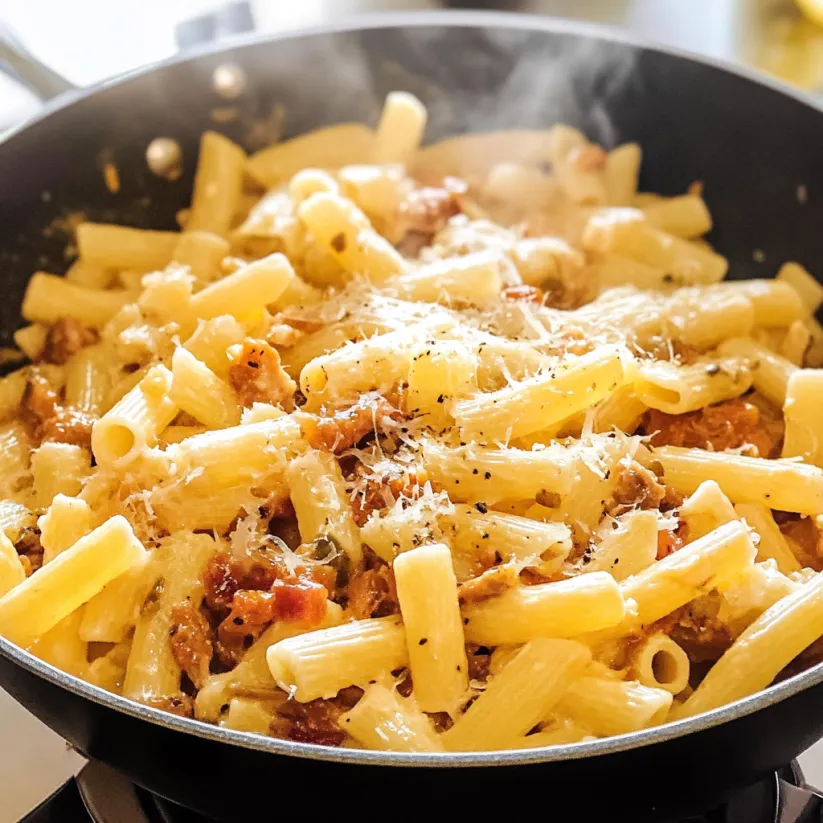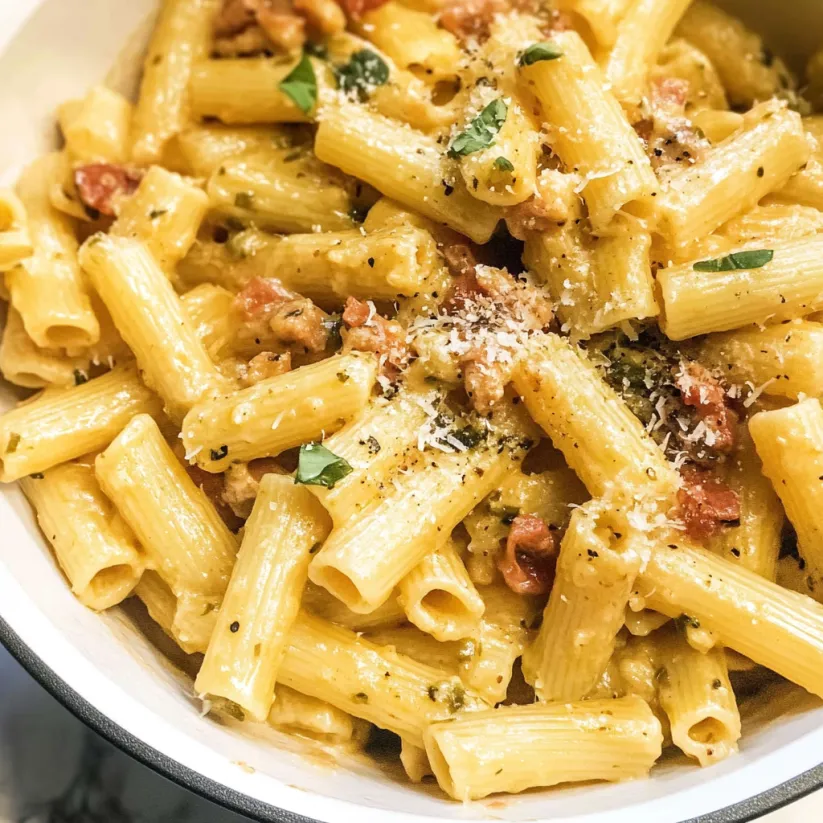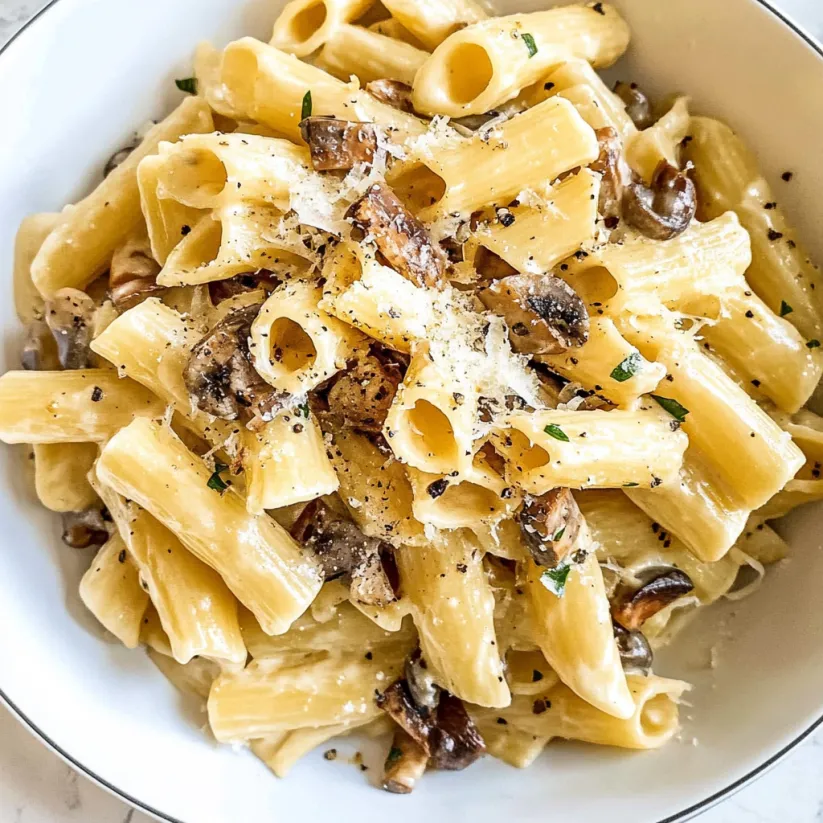 Bookmark
Bookmark
This savory 4-ingredient classic Italian Pasta Alla Gricia recipe is full of so much delicious flavor as perfectly rendered guanciale and Pecorino Romano cheese come together to make a sauce with freshly ground black pepper. It's a 20-minute meal that is simplicity at its best and a perfect example of why Italian cuisine is known for taking simple ingredients and turning them into iconic dishes that are easy to make and layered in so much flavor.
I first discovered Pasta Alla Gricia while traveling through Rome and was amazed how something with so few ingredients could taste so luxurious. This has become my go-to dish when entertaining friends who think Italian cooking is complicated.
Ingredients
- Rigatoni or other small shaped dry pasta: The tubular shape captures the sauce perfectly inside and out
- Guanciale: cut into ¼-inch pieces Traditional Roman cured pork jowl that adds incredible depth of flavor
- Black pepper: freshly ground A key flavor component that gives the dish its signature kick
- Pecorino Romano cheese: finely grated Look for authentic PDO marked cheese for the most authentic sharp and salty flavor
Step-by-Step Instructions
- Render the guanciale:
- Add the guanciale to a large skillet and cook over medium heat for about 10 minutes until it becomes crispy and golden in color. Patience is essential here to fully extract the fat and flavor. The rendered fat will become the foundation of your sauce. Once crispy, transfer the guanciale to a plate but leave about 2 tablespoons of fat in the skillet.
- Boil the pasta:
- While the guanciale renders, bring a large pot of generously salted water to a boil. Add the rigatoni and cook until al dente, typically one minute less than package directions. Before draining, reserve 2 cups of the starchy pasta cooking water, then drain the pasta.
- Start the sauce:
- Add freshly ground black pepper to the rendered fat in the skillet and cook for about a minute to bloom the flavor. Add 1 cup of the reserved pasta water, turn heat to high, and boil until reduced by half. This concentration creates the base of your sauce.
- Add the pasta:
- Add the cooked rigatoni to the skillet and toss thoroughly with the rendered fat and reduced pasta water mixture. Use a wooden spoon for gentle mixing and add more reserved pasta water if needed. The pasta should be completely coated but not swimming in liquid.
- Add half of the cheese:
- Stir half of the finely grated Pecorino Romano into the pasta until fully incorporated. The heat will melt the cheese into the sauce creating a creamy texture. The sauce should look glossy and cling to each piece of pasta.
- Add the guanciale:
- Return the crispy guanciale to the pasta and toss gently to distribute throughout the dish. This maintains the crispy texture while allowing the pork flavor to permeate the entire dish.
- Finish with cheese and serve:
- Garnish with remaining Pecorino and more freshly ground black pepper. Serve immediately while hot to experience the ideal creamy texture.
 Bookmark
Bookmark
My absolute favorite part of this recipe is the moment the cheese melts into the starchy water creating that magically silky sauce. I remember my Italian grandmother teaching me to listen for the specific sound the wooden spoon makes against the pan when the sauce reaches perfect consistency.
The Roman Trilogy
Pasta Alla Gricia is one of Rome's three classic pasta dishes, alongside Carbonara and Amatriciana. In fact, it's considered the original from which the others evolved. Carbonara adds eggs, while Amatriciana incorporates tomatoes. Understanding this historical context helps appreciate the brilliance of Gricia's simplicity and why preserving the traditional preparation matters so much to Romans.
 Bookmark
Bookmark
Choosing The Right Guanciale
Guanciale is the heart of this dish, but finding true guanciale can be challenging outside Italy. Look for it at Italian specialty shops or high-end butchers. The fat marbling should be generous and the meat should have a pinkish hue. If you absolutely cannot find guanciale, pancetta makes the next best substitute, though the flavor profile will be slightly different. Never use bacon, as its smoky flavor overwhelms the delicate balance of the dish.
Perfecting Your Pasta Water
The pasta water serves as both a thickener and flavor carrier in this recipe. To maximize its starchy power, cook your pasta in less water than you might normally use, about 2 quarts for 12 ounces of pasta. This concentrates the starch released from the pasta. Additionally, season your water properly it should taste like seawater, which typically requires about a tablespoon of salt per pot.
Serving Suggestions
Pasta Alla Gricia needs little accompaniment. If serving as part of a larger meal, pair it with simple roasted vegetables dressed only with olive oil and salt, or a crisp green salad with a light vinaigrette. Wine pairing is crucial a dry, acidic white like Frascati from the Rome region cuts through the richness perfectly, or try a medium-bodied red like Montepulciano d'Abruzzo.
Frequently Asked Questions
- → Can I substitute guanciale with something else?
Yes, if guanciale is unavailable, pancetta makes the closest substitute. Thick-cut bacon can work in a pinch, though it will alter the flavor profile slightly. Guanciale's unique fat content and flavor are ideal, but the dish will still be delicious with these alternatives.
- → Why is it important to reserve pasta water?
The starchy pasta water is crucial as it combines with the rendered fat and cheese to create the silky sauce. The starch helps emulsify the ingredients, while the salinity seasons the dish. Without it, the sauce wouldn't achieve its signature creamy, glossy texture.
- → What's the difference between Pasta Alla Gricia and Carbonara?
While both dishes use guanciale and Pecorino Romano, Carbonara includes eggs which create its distinctive custard-like sauce. Pasta Alla Gricia is sometimes called 'white Amatriciana' or 'Carbonara without eggs' as it shares core ingredients but offers a cleaner flavor profile focused on the guanciale and cheese.
- → What pasta shape works best for this dish?
Rigatoni is traditional as its ridges and hollow center capture the sauce beautifully. Other good options include bucatini, spaghetti, or mezze maniche. The key is choosing a shape that can hold the sauce effectively - either with ridges, texture, or a hollow center.
- → Why shouldn't I add salt to the sauce?
The dish gets sufficient salt from three sources: the salted pasta water, the cured guanciale, and the aged Pecorino Romano cheese. Adding extra salt would likely make the dish too salty. It's one of the few pasta dishes where additional seasoning beyond black pepper is rarely needed.
- → How do I know when the guanciale is properly rendered?
Properly rendered guanciale should be golden brown and crispy, with most of its fat released into the pan. This typically takes about 10 minutes over medium heat. Patience is key - rushing this step will result in less flavor in the final dish. You should end up with crispy meat pieces and approximately 2 tablespoons of clear fat in the pan.
